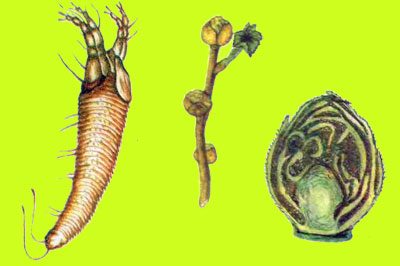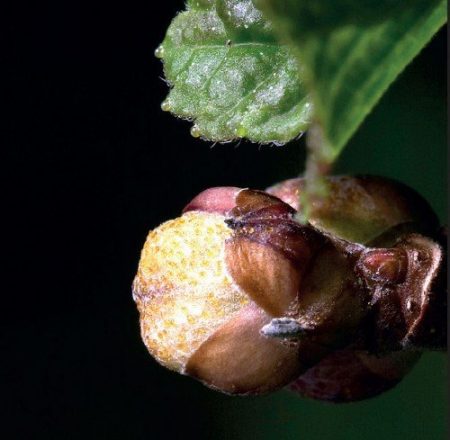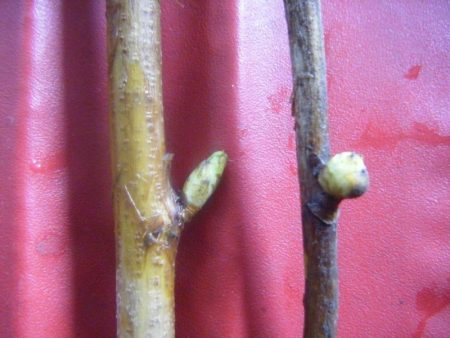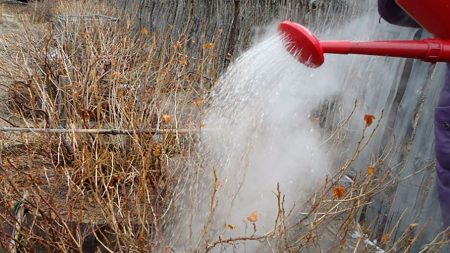Currant bud mite is a very dangerous pest of currants. It mainly affects black currants, but there are also varieties of red currants that are sensitive to the mite. In particular, the Red Cross variety and the Dutch variety Jonker van Tets are very heavily damaged by the pest.
What is a kidney mite?
The bud mite is a pest that damages currant buds. He spends almost his entire life in them.If it is allowed to spread uncontrollably in plantings, it will soon lead to the death of the plantings.
The pest has microscopic dimensions: females are only 0.2-0.3 mm in size, males are even smaller. Lives, feeds and reproduces in the kidney. The body of the mite is white, slightly elongated, and under a microscope resembles a worm. One bud can contain up to 3-5 thousand individuals, as well as eggs and larvae of the pest.
In winter, the tick hibernates. When the air warms up to +5°C, the females lay eggs, from which larvae appear after 7-12 days, feeding in the same kidney. During the growing season, 3-4 generations of pests are born. All hatched larvae and adult ticks live and feed in the same “house” until spring. In spring they migrate to neighboring buds and bushes.
Attention: Ticks are carriers of currant blight, an incurable viral disease of currants.
Pest dispersal
In the spring, when the buds emerge, the migration of larvae and mites begins in search of a new food supply. The migration period is 25-30 days, but special activity is observed during the flowering of black currants. Mites actively colonize new buds. During this period, if you look closely, you can see pests - these are small white dots that move along the shoots to the blossoming leaves.
Ticks are transferred passively to neighboring currant bushes by wind, water, on clothing and garden tools, with insects and birds. It can enter the garden with contaminated planting material, which cannot always be distinguished from healthy material. After burrowing into a kidney, the mites do not emerge from it until next spring.
Signs of mite damage to currants
Affected currant buds change color, become yellowish-green, and loose.The apical cone becomes rounded, the bud itself becomes rounded, swollen, resembling a head of cabbage or a pea. The more mites are inside, the more the bud swells. In spring, such buds become a breeding ground for pests. They do not bloom, but rot or dry out.
On black currants, if there are a lot of mites inside, then these buds are noticeable already at the end of summer, and by autumn, as the mites multiply, they acquire a characteristic round shape. On red currants, healthy and diseased buds are almost indistinguishable from each other; they never increase in size. You can suspect that red currants are infected with a pest only when the leaves bloom, when the diseased buds rot and fall off without blooming. An indirect sign of bud mite on red currants is a decrease in yield of seemingly healthy bushes.
But if there are no more than 300 ticks inside, then the kidney at first glance looks quite healthy. It does not change in color or shape. Only upon careful examination can one notice that the cone has turned from sharp to round, and the covers have acquired some looseness. This means that there are already mites there, and it is only a matter of time before full signs of infestation appear. But usually gardeners do not pay attention to such buds, believing that they are free from mites.
How to deal with bud mite on currants
Measures to combat the tick are very difficult, since almost its entire life it is protected from the effects of adverse factors and pesticides by its kidney scales. The most favorable period for pest control is the time of their migration to new buds. However, at this moment the currant is blooming and the use of strong and, especially, toxic drugs is extremely undesirable.But, at the same time, they turn out to be the most effective means of combating ticks.
The main measures to combat ticks are the following.
- Manual collection of diseased buds 2 times per season: in spring and autumn. But this measure is not effective enough, since at the initial stage and a small amount of the pest, the bushes look quite healthy.
- Removing severely damaged branches. The measure is also very conditionally effective.
- If the bush is heavily infected, then it is completely cut out. Growing shoots are usually free from mites.
Cuttings cannot be taken from affected bushes, but if it is necessary to obtain planting material from this particular currant bush, then it is propagated using horizontal layering.
Preparations for processing currants. All pesticides are used only in the spring, when ticks migrate; the rest of the time they are not effective.
- Treatment of bushes with sulfur preparations. Sulfur has a moderate acaricidal and insecticidal effect. The main pesticides for tick control are colloidal sulfur and the drug based on it, Tiovit Jet. You can spray currant bushes throughout the flowering period, since sulfur is not toxic to flowers and ovaries and does not accumulate in them. But to combat ticks, it is effective only at a temperature of at least +20°C.
- If the temperature is below 20°C, then you can cover the bush with film, tying it at the bottom, and set fire to the sulfur bomb inside. The generated hydrogen sulfide causes the ticks to suffocate and die. This will also be a good prevention of powdery mildew. The film is left for 24 hours.
- Treatment with biological products: Bitoxibacillin, Agrovertin, Fitoverm. They have a good effect at temperatures above 18°C. The lower the air temperature, the less effective biological products are.
- Spraying currants with insecto-acaricide Mavrik. The drug has a long-term protective effect, causing the death of ticks and their larvae, as well as other harmful insects. It is safe for bees and is often used by beekeepers to combat parasitic diseases in the apiary.
- Neoron. A long-acting acaricide (10-40 days depending on the weather), causes the death of ticks.
- Acaricide Apollo. The drug sterilizes ticks, but does not kill them. As a result, pests do not reproduce and the eggs become sterile.
During the season, 2 treatments are carried out: before flowering and immediately after it.
Drugs such as Iskra, Kinmiks, Decis, Karbofos, Karate, Fury, Inta-Vir, Aktara, Sherpa and other insecticides are completely useless in the fight against kidney mites.
Folk remedies for fighting kidney mites
These methods of control are more preventive than curative.
- One of the most famous remedies is pouring boiling water over the bushes. Ticks are very sensitive to high temperatures and with this treatment some of them die. But for the effect to be noticeable, it is necessary to treat the currants with boiling water several times with an interval of 3-4 days. Douse the bushes only when the air temperature is not higher than 4-6°C; if the temperature is higher, you can cause significant harm to the currants. Treatment is carried out in early spring.
- During the migration period, currants are sprayed with decoctions that have a strong odor. Decoctions of tobacco and onion peels are suitable for combating mites. First, prepare the concentrate by pouring 150-200 g of raw material with water and bringing it to a boil. Then filter, bring to 10 liters and process the bushes.
- Using garlic infusion. 150 g of crushed cloves are poured with a liter of water and left for 2 hours.Bring the volume to 10 liters and spray the currants. After 5-6 days the treatment is repeated.
- Used tea leaves (100 g) are poured into 5-7 liters of water and treated twice when the buds open and after flowering.
Prevention of kidney mite infection
The main preventive measure is healthy planting material. Brought seedlings are completely immersed in hot water at a temperature of 45-50°C for 10-15 minutes. If you don’t have a thermometer, then the water should be such that your hand can just withstand that temperature.
If you have Fitoverm, then seedlings and cut currant cuttings are kept for 2 hours in a working solution of the drug before planting.
If the seedlings are large and it is not possible to place them completely in water, then they are placed in the shade, the roots are immersed in a bucket of water and covered with film for 24 hours. In case of cold (not higher than 20°C) and cloudy weather, cover with black film, if the weather is warm and clear, then cover with white film. Currants withstand all kinds of heating well, but mites die at high temperatures.
An excellent effect in the fight against mites is obtained by growing varieties that are resistant to the pest, then the fight against it comes down to collecting single damaged buds, or not at all.
Classification of blackcurrant varieties according to resistance to bud mite.
| Sustainable | Weakly damaged by ticks | Unstable |
| Minx | Orlovia | Gulliver |
| Tatyana's Day | Belarusian sweet | Summer resident |
| Ruffy | Nadina | Crane |
| Perun | Gamma | Green haze |
| Izyumnaya | Dobrynya | Nara |
| Binar | Zusha | Exotic |
| Bychkovskaya | Oryol Waltz | Mascot |
| Memory of Michurin | Selechenskaya | Tamerlane |
| Cardinal | Black Pearl | Chebarkul |
An effective means of control is to plant plants with a strong odor between the bushes that repel the pest.The most suitable are perennial onions and garlic.
Obtaining planting material from infected bushes
If a very valuable currant variety affected by a mite needs to be preserved, but it is not possible to leave it on the plantation due to the strong spread of the pest, then proceed as follows.
In early spring, horizontal layers are made, covering them with 8-12 cm of soil. Only the crown with 1-2 buds is left on the surface. Ticks cannot live underground and die, and their eggs also die. The cuttings that have grown over the summer will be clean. The crown of the shoot, which was on the surface of the soil, is removed because it may be infected with a mite. This is the most effective measure to save the desired variety.
If a tick gets onto a plantation, the fight against it must begin immediately, otherwise it will quickly spread, and it is very difficult to remove it. A reliable guarantee against pests is the cultivation of resistant varieties.





 (5 ratings, average: 4,20 out of 5)
(5 ratings, average: 4,20 out of 5) CUCUMBERS NEVER GET SICK, I'VE BEEN USING ONLY THIS FOR 40 YEARS! I SHARE A SECRET WITH YOU, CUCUMBERS ARE LIKE THE PICTURE!
CUCUMBERS NEVER GET SICK, I'VE BEEN USING ONLY THIS FOR 40 YEARS! I SHARE A SECRET WITH YOU, CUCUMBERS ARE LIKE THE PICTURE! You can dig a bucket of potatoes from each bush. Do you think these are fairy tales? Watch the video
You can dig a bucket of potatoes from each bush. Do you think these are fairy tales? Watch the video
 How our fellow gardeners work in Korea.There is a lot to learn and just fun to watch.
How our fellow gardeners work in Korea.There is a lot to learn and just fun to watch. Eye trainer. The author claims that with daily viewing, vision is restored. They don't charge money for views.
Eye trainer. The author claims that with daily viewing, vision is restored. They don't charge money for views. A 3-ingredient cake recipe in 30 minutes is better than Napoleon. Simple and very tasty.
A 3-ingredient cake recipe in 30 minutes is better than Napoleon. Simple and very tasty. Therapeutic exercises for cervical osteochondrosis. A complete set of exercises.
Therapeutic exercises for cervical osteochondrosis. A complete set of exercises. Which indoor plants match your zodiac sign?
Which indoor plants match your zodiac sign? What about them? Excursion to German dachas.
What about them? Excursion to German dachas.